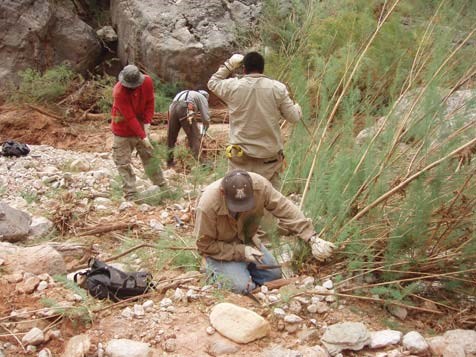The information on this page is provided for reference purposes.
NPS Tamarisk, (Tamarix spp.) commonly known as salt cedar, is an exotic (non-native) shrub or tree that grows in dense stands along rivers and streams in the west. Tamarisk, introduced to the U.S. in the 19th century as an erosion control agent, spread through the west and caused major changes to natural environments. Tamarisk reached the Grand Canyon area during the late 1920s and early 1930s, becoming a dominant riparian zone species along the Colorado River in 1963 (following completion of Glen Canyon Dam). Through a public review process, called an Environmental Assessment / Assessment of Effect, park management evaluated the impacts to natural, cultural and wilderness resources, and solicited public comments. Through this process the environmentally preferred alternative was selected, and includes the control of tamarisk in side canyons, tributaries, developed areas, and springs above the pre-dam water level of the Colorado River within Grand Canyon National Park. Crews remove tamarisk through a combination of mechanical and chemical controls, allowing for native vegetation to recover. The size of the plant usually dictates how it is removed. Methods include pulling, cutting to stump level, or girdling it to leave the dead tree standing for wildlife habitat. The combination of hand tools and herbicide ensures maximum effectiveness with minimum impact to visitors and the environment. The particular method used is specific to each site and determined by the restoration biologist or on-site project leader. Legacy Reports and Documents List — for ResearchersCopies of these reports are available by request from Grand Canyon National Park's Museum Collection/Archive. > Submit an email request. Tamarisk Site BulletinTamarisk Management and Tributary Restoration March 2011 (240 kb PDF File) Tamarisk Program Overview PosterTamarisk Management in Grand Canyon: Past Challenges, Current Efforts and Future Direction February 2009 (213 kb PDF File) Grand Canyon Exotic Plant SpeciesVegetation Management Bulletin (117 kb PDF File) Tamarisk Eradication and Tributary Restoration Project ReportsPhase I Final Report 2005 (3.12 MB PDF File)Tamarisk Eradication and Restoration of 63 Tributaries Phase II-A Final Report 2007 (1.50 MB PDF File) Management & Control of Tamarisk and Other Invasive Vegetation at Backcountry Seeps, Springs and Tributaries in Grand Canyon National Park Phase II-B Final Report 2008 (2.5 MB PDF File) Management & Control of Tamarisk and Other Invasive Vegetation at Backcountry Seeps, Springs and Tributaries in Grand Canyon National Park Finding of No Significant Impact - July 2002FONSI Tamarisk Management and Tributary Restoration (212 kb PDF File) Environmental Assessment - February 2002EA Tamarisk Management and Tributary Restoration (1.6 MB PDF File) |
Last updated: April 30, 2023
